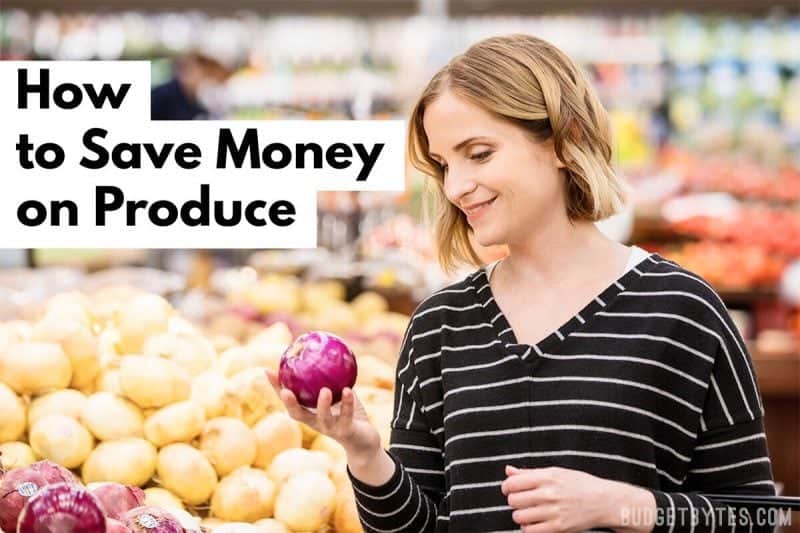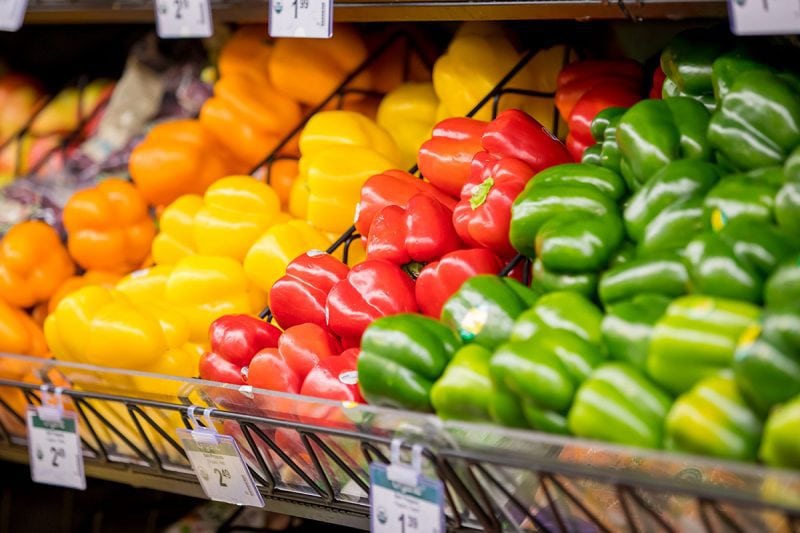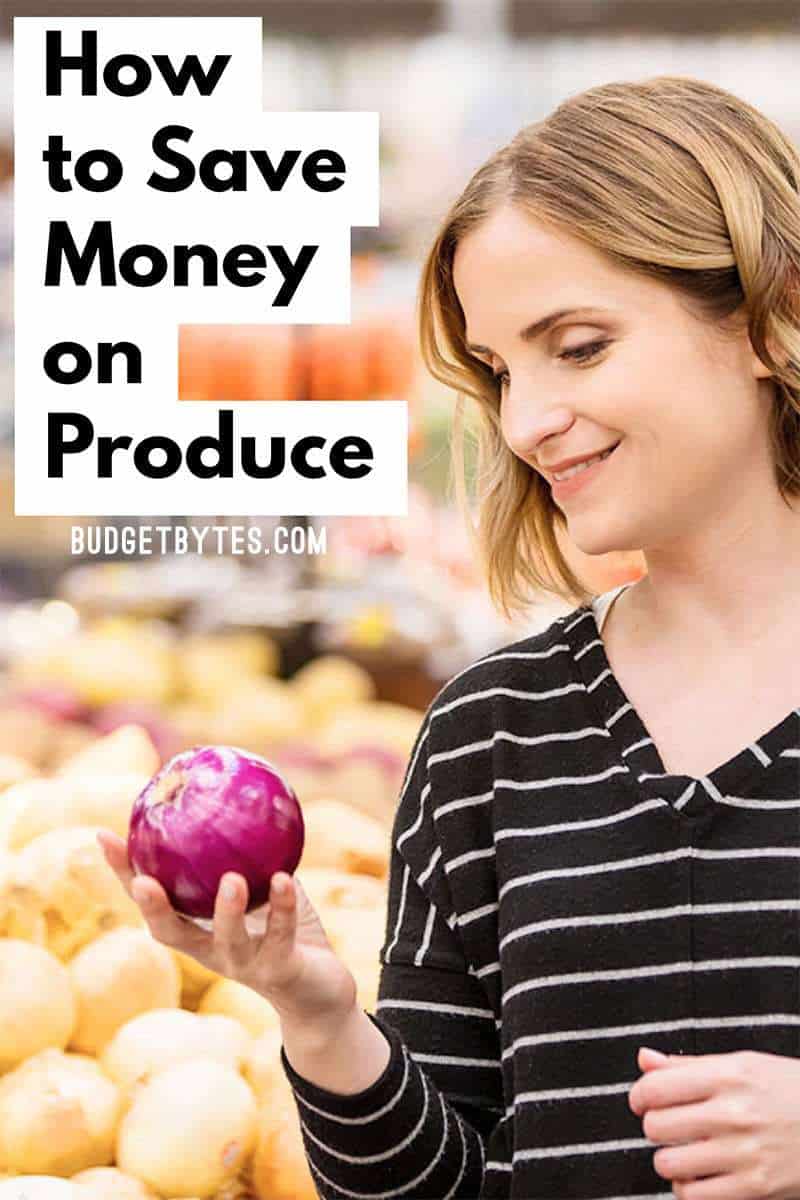One of the biggest misconceptions I encounter is that eating healthy is really expensive. Well sure, it can be, if you don’t shop smart. But that’s why I’m here. I’ve scoured the markets, made the mistakes, and learned the lessons for you. After years of trying to eat within a super strict budget, I’ve come up with these easy and practical tips to save money on produce and fill your plate with a rainbow of colors, even when your bank account is running on empty.

This post contains some affiliate links, which means that we make a small commission off items you purchase at no additional cost to you.
Buying produce on a budget is all about picking the right items, at the right time, and in the right form, and it will likely be different for every person depending on where you live. Here’s a quick video introducing my techniques, but you can scroll down for a more in depth look at each tip, plus a few more!
Buy In-Season Produce
Okay, we’ve all heard this tip, but what does it actually mean and how does it save you money? In today’s global agriculture market, it’s a little more difficult to tell what is in season because many items are available year-round, but when produce that is grown in your region is in it’s harvesting season, you’ll notice a glut at the grocery store. That sudden increase in supply drives the prices down, all while providing you a fresher, more flavorful product than items that are technically grown “out of season” and half way around the world. Growing seasons differ from region to region, but if you keep your eyes open you’ll start to notice the patterns. Or you can consult any of the handy charts online, like this one from the USDA, to get a general idea. And if you do score a really super deal on seasonal produce, freeze it! Stock your freezer with your goods to use later and lock in that awesome in-season price.
Stick to Sturdy Vegetables
One of the easiest ways to save money on produce is to stick to sturdy fruit and vegetables. Delicate fruit and vegetables, like berries or baby greens, spoil quickly and therefore the growers and grocery stores carry a higher monetary risk to keep them stocked on their shelves. They cover that risk by raising the price. Instead, stick to sturdy vegetables that are very shelf stable, like cabbage, sweet potatoes, celery, onions, carrots, potatoes, kale, collards, apples, and oranges. Not only do they cost less at the store, but they’ll last longer once you get home, so you’re less likely to find them wilted in your crisper a day later.
Pay Attention to Pricing
Grocery stores usually price produce one of two ways: per pound, or per item. This can make a big difference in the total cost. For instance, a bag of grapes may have a big sign that says $2.99, which sounds great, until you realize that’s actually per pound and that bag of grapes weighs three pounds! That’s a $9 bag of grapes! Paying attention to pricing method is also important when comparing packaged produce to loose produce. You may see a bag of carrots for $1 each and loose carrots for $1.49 per pound. Check the weight of the bag of carrots so you can compare the per pound price for both.

Buy Regional Produce
Buying local is a huge trend, but it can also help you save money on produce! When produce has to travel across the country or across the globe the cost of that transportation gets absorbed into the price you’re charged at the checkout. As an added bonus, since regional produce has less distance to travel and can make it from farm to store faster, it’s usually picked closer to its peak ripeness and will have better flavor. So, tropical fruits and vegetables may be very inexpensive in the southern United States, but more expensive in the north, while cold weather fruits and vegetables, like apples and plums will be less expensive in the north and more costly in the south.
When You Can’t Buy Fresh, Buy Frozen
Frozen fruit and vegetables can be an excellent budget saver. When produce is out of season or expensive for other reasons, I turn to the freezer aisle. Frozen produce is not only convenient because it’s often pre-chopped and ready to toss into a recipe, they have an extremely long shelf (freezer) life, so you don’t have to worry about them spoiling if you don’t use them up right away. When shopping for frozen vegetables, stick to the plain vegetables that don’t come with sauces or seasonings, and buy larger bags to save more!
Shop Outside the Box
Some of the best places I’ve found for excellent quality produce at a low price are international markets. I haven’t quite figured out the why behind this, but I think it’s because other cultures use a lot more produce in their regular diet than Americans, so international markets have a higher turnover rate for their produce and can afford to stock better produce at a lower price. That’s just my guess, but whatever the reason, if you have a large Asian grocery or other international market in your area, check their produce! You may be pleasantly surprised. Also make sure to look into local CSAs (Community Supported Agriculture), and local farmers’ markets in your area.
Still Not Convinced?
On average I’d say I spend around $1.50/lb. for produce, and sometimes far less. Compare that to that $4 bag of chips. The bag of chips may look big, but it weighs next to nothing. Meat and dairy are going to be at least twice as much per pound than produce, if not more. If you pick the right produce at the right time, it can be one of the least expensive items in the grocery store. Stock up, eat healthy, and be happy!
Got Produce? Now What?
Now that you’re a pro at getting tons of fruit and vegetables at a bargain, what do you do with it? Browse our Vegetable Category for recipes, or check the Ingredient Index to filter recipes by specific ingredient/fruit/vegetable.
What are your favorite ways to save money on produce? Leave your tips for the other readers in the comments below!



I bought a dehydrator through a MeetUp list serve for $10. (Another possibility is NextDoor, on line all over the country). I grow my herbs from seed, plant them at my daughter’s house, then dry them—tons of them. If you want to think about the price of something per pound—think what a few ounces of a dried herb costs. For that matter, what a handful costs fresh. And what you dry yourself tastes great. Some herbs you can just hang up somewhere. But basil is a pill to preserve. Grated citrus peel, chopped onion, finely chopped celery, chopped mushrooms, etc. aren’t actually herbs, but I consider them to be.
For a few months this summer we have tomatoes from our garden, but most of the year I have to go to the grocery store for my “fix.” They are expensive if you crave heirloom tomatoes and even the cherry or grape kind, and quite expensive if you like organic. It is easy to save money by buying several cheaper roma tomatoes and then one heirloom. When combined with a good dressing they all taste divine. A few more “tips”: buy the less expensive yellow onions rather than the preferred reds and sweeten them by soaking slices in cold water for a half hour. Altho eggplant is delicious, you can sub less expensive zucchini in many eggplant dishes (except baba ganoug); zukes make a better parmesan IMO. To conjure up a fresh herb experience, just buy some fresh parsley and add other dried herbs to that for a full flavor. I know this all sounds extremely penny pinchy, but produce costs do add up and I just wanted to add a few more tips. And even if you have your weeks meals envisioned and planned, be flexible and when you get to the store always consider buying the stuff that is on sale, and you’ll be forced to be creative.
Great added tips. Thanks!
Great post! One of the ways I planned my meals by season was to check the date your blog post was originally published; that gave me a decent guide of what might be in season for me. Unfortunately, I looked for that date in the URL of the post, and the SEO goodness of renaming your URLs meant I don’t have that clue anymore. Awesome for other people to find your blog, though! I wonder if you have another way I could gauge when your recipes were originally posted?
On Firefox, right click the page and select “View Page Info”. In the list of meta tags, you’ll find “article:published_time”, which will tell you when the article was posted.
If you are on another browser, you can view the source code (again, by right clicking the page) to find the same information. (Use Ctrl+F to quickly look for “published_time” in the source code.)
Hey Erin! Thanks for bringing that to my attention! I just added a widget to the sidebar that should help. It’s a drop down menu that lists the blog posts by the month they were posted. :)
Make vegetable broth for cooking. I keep a gallon bag in my freezer for veg scraps: peelings, root ends, stems from greens, stems from herbs, squash skins, meal leftovers too small to keep, etc. When the bag is full it goes in the stock pot with 10-12 cups of water, some onion and garlic, salt and bay, and part of a sheet of dried seaweed. Simmer for a few hours, strain, and store.
1) Don’t assume farmer’s markets or even organic produce is more expensive. Instead go towards the last half hour of the market – when vendors often offer deals so they don’t need to transport their produce back — or ask for “seconds” (produce which doesn’t look good cosmetically but are perfectly edible).
2) Really get to know the price of things so you know when there is a good bargain. For instance, where I live, when organic apples drop below $1.99 a pound, I know they are a steal. 3) Shop at Aldi’s or Trader Joe’s. Where I live, stores like Safeway — which might be viewed by some as the middle=of-the range are actually quite expensive and the quality is not necessarily better. I’ve introduced a few people to TJ’s who assumed it was pricy without bothering to check it out. 4) I agree with the comment about how farmer’s market produce lasts longer. I have had beans from the supermarket spoil within a few days vs. the 10 days that beans can last from the farmer’s market and still look/ taste good. That’s because supermarket beans are likely older — being trucked in — vs. the farmer’s beans which were just picked the day of or before the day I bought them.
Sometimes I look on the cart with the almost-past fruits and vegetables. I could use some of those apples to make the hand pies. Once I remove the bad parts, the apples are fine for baking.
Also, if the red or yellow peppers look okay, I’ll get them, slice, and freeze for pizza.
I also like to buy a large bunch of bananas. I just shop for 1 so I just eat a few and let the rest get very ripe. I peel them, cut in half, put 2 bananas per bag, then freeze for breads and smoothies.
I rarely buy produce from the big box grocery stores. I am blessed to have many ethnic markets within a few miles from my home. It’s amazing to me how much I save on produce. .I also have a place called Specialty Produce who sells to restaurants and hotels. They don’t always have the lowest prices but their products are high quality. Common things like lettuces, mushrooms, and in season produce can be very reasonably priced.
Thanks for sharing this great post
My local Giant marks down produce on Sunday night, so I’m there every Monday morning to buy up whatever looks good. Things like apples (perfect for applesauce), bell peppers (I either chop and freeze or make stuffed peppers ASAP), citrus fruit (fresh squeezed juice to drink, or lemon juice frozen in ice cube trays), and other produce can be purchased for no more than $.99/lb., and usually less than that. I just make sure that I have a specific use in mind for anything I buy, and that I can use or freeze it quickly – that same day, if possible.
I love it! I wish all stores did this.
Use about-to-go-bad veggies in a curry, just about anything tastes good in it!
I’ve also found that produce from the local farmer’s market (Pike Place for me) is more expensive but also lasts WAY longer. Totally worth it when my bag of parsley lasts for 3 weeks!
I love it! Curry fixes anything. :) And I’m jealous that you have Pike Place near you!
Lots of stores price match – great way to get produce at a good price without having to drive around. Also, my local grocery store sells naturally imperfect vegetables – same great taste, just not as pretty as some. I chop them up anyway so I don’t notice that it’s not a perfectly round tomato or 2 mushrooms grew together.
I love it! I wish all stores had an “imperfect” produce section. That would increase access to healthy food and reduce waste in one swoop!
Great article! I just discovered Hungry Harvest which delivers “seconds” (less pretty or small or a little beat up) produce for a huge discount. I tried to do a CSA but it was all kinds of unusual veggies and I don’t always want to deal with finding new recipes and cooking them all before they spoil.
I’m going to have to check that out, thanks for the tip! There is another company called Imperfect Produce, but they don’t operate in my area. I hope Hungry Harvest does!
A big thing too is to learn how to use leftover veggies that are about to go bad – I love using them in an omelette on the weekends, a stir fry for dinner, or making veggie fried rice to makes sure I don’t waste the stragglers!
Very true! ❤️
I ask the produce people for untrimmed, unbanded leaf lettuce. I then put it in a bag available in the produce department. Not only do I get more, but it is unbruised. Then, when I have an opportunity to give store feedback, I recognize the person who made the effort to get it for me from the back room.
Wow, that’s an excellent tip!! I’ve never thought about doing anything like that. Thanks for sharing!
And another Beth rip, use those “sturdy” veggies to stretch your meat dishes (along with rice, pasta, and other cheaper ingredients). More frugal advice, please!